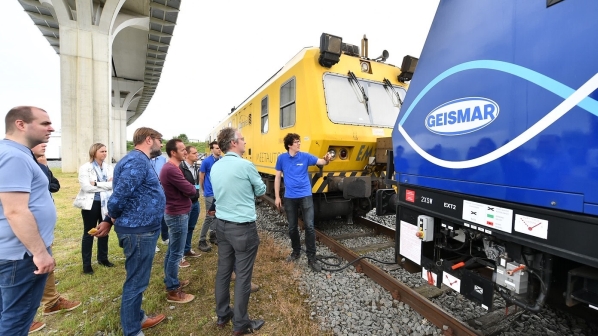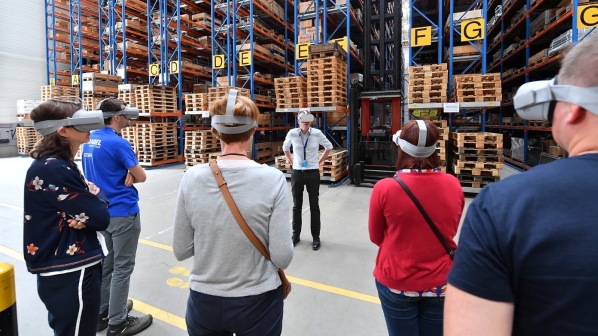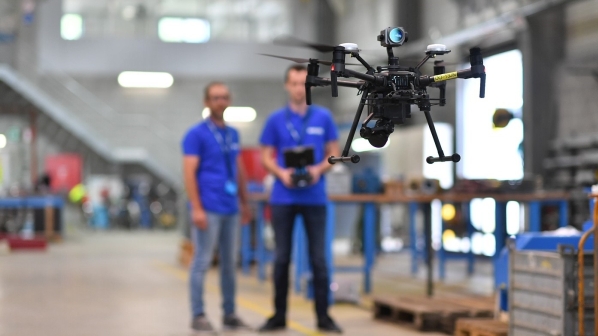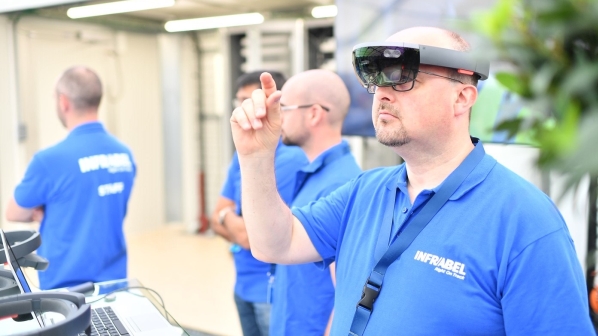In a temporary building, 18 separate exhibits demonstrated innovations including Building Information Modelling (BIM) for project development, mapping drone images to support infrastructure monitoring, and Lidar detection for lineside vegetation management.
Outside, visitors were invited to board two of Infrabel’s inspection vehicles, EM130 and EM201. Developers showed off the latest catenary and signalling infrastructure inspection technology using high-definition cameras and shock detecting equipment as well as track and switch condition monitoring equipment, all of which foresee future Artificial Intelligence (AI) applications. And at the workshop itself, a virtual reality presentation offered insight into a glimpse of centralised spare part supply using automated technologies and logistics techniques pioneered by companies such as Amazon.

Each of the technologies on show are at different stages of development, from initial proof of concept and prototyping to some solutions which have or are being rolled out into live operation.
Infrabel began the process of digitalising its infrastructure in 2014 under the Smart Railway Project. In the beginning this involved the painstaking process of digitising much of the infrastructure and assets. Paper records have been replaced with online databases, which offer a history of a specific asset and are accessible at the trackside using a tablet computer.
This data - the fuel of the fourth industrial revolution - is also supporting the development of new innovations. In general these are divided into three categories: protecting people and safety; mobile inspection; and train management of the future.

The technologies that Infrabel has or is on the verge of introducing were on display at Schaerbeek, and among them were:
- Drones: Infrabel is already using 10 drones to monitor the condition of infrastructure such as GSM-R masts, catenary and bridges as well as to observe construction sites and areas where incidents have occurred. Seven Infrabel staff members are trained as pilots while the Schaerbeek site will soon benefit from an automated drone system to monitor potentially vulnerable assets such as copper cabling. The use of drones is also supporting “drone to map” applications, including three-dimensional modelling of assets and infrastructure, helping to inform maintenance planning processes.
- Automatic Train Warning system for use by track maintenance staff: developed by Zöllner, Germany, this mobile system manually controls signalling in a localised area and informs track workers of an approaching train so they can leave their worksite safely. The operator uses an RFID tag to inform the system that workers have left the area, enabling the train to proceed without disruption and ensuring that track workers are safe.
- Building Information Modelling: Infrabel is using BIM to support the development of new projects so developers and users have an accurate picture of how a new piece of infrastructure will operate and be used before it is built. These techniques are helping to prevent costly errors and to optimise construction techniques.
Other concepts which are in the early stages of development and may be of use in their current or an evolved form include augmented reality applications for maintenance personnel. In these applications, specially designed headsets can offer the status of specific components and instructions for maintenance tasks, leaving the technician’s hands free to work. Work is also underway to develop a smart traffic management solution. The solution on show utilises a digital twin to model potential disruptions to operation while harnessing AI to make the best traffic planning decision depending on the location and type of incident.

For Mr Carel Jockheere, smart railway programme director at Infrabel, the objective of the overall programme is to improve the efficiency and effectiveness of the IM’s working processes.
With Belgium boasting one of Europe’s busiest railway networks - 6500km of main line track currently serves 4000 trains every day - Infrabel is under pressure to deliver highly reliable infrastructure which meets the needs and expectations of increasingly-demanding customers. This means replacing manual inspections requiring track possessions with automated processes which minimise line closures. It also means shifting from interval-based to predictive maintenance.
“The maintenance procedures that we carry out, replacing track and repairing infrastructure, will remain largely the same,” Jockheere says. “What we can do differently is to use this time more effectively and make more informed decisions of what needs to be replaced at a specific time.”
Inevitably this presents challenges: maintaining up-to-date databases; reacting to new technologies as they become available, notably 5G, automatic train operation and automated road vehicles; and effectively processing the huge volumes of data retrieved - a single inspection vehicle shift of six to eight hours can produce 2.5-3 terabytes of data. It is therefore a major challenge to use this data in a manner that improves rather than overwhelms the decision making process.
Critically though it requires the cooperation of staff, both to innovate and support the objectives of the programme, and to accept and adopt the new ways of working.
“The biggest challenge we face is to channel the enthusiasm and innovative spirit of Infrabel staff to deliver usable solutions,” Jockheere says. “This has been central to our progress and success so far, and will remain so in our future work.”
A detailed breakdown of the innovations on show at Digital Days will appear in an upcoming edition of IRJ.

